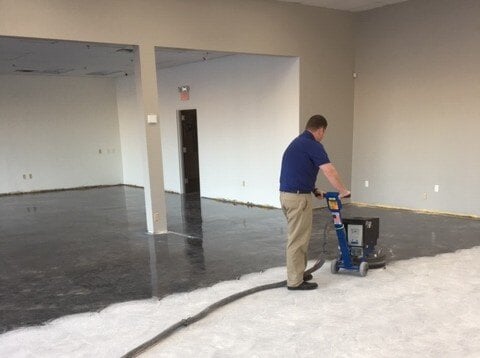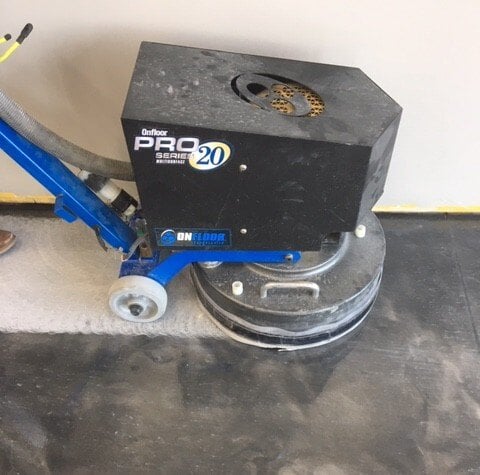Welcome to our guide on how to epoxy a basement floor. An epoxy basement floor is a popular choice for homeowners looking to add durability and aesthetics to their basement floors.
In this article, we'll cover everything you need to know before taking on epoxy basement floor coating, including preparation, application, and maintenance tips.
What Is Epoxy?
Epoxy is a type of resin that, when mixed with a hardener, creates a strong and durable coating. It is commonly used for floors in commercial and residential settings thanks to its high resistance to wear and tear, chemicals, and moisture.
Epoxy coatings come in different colors and finishes, including solid colors, metallic effects, and even glow-in-the-dark options. This allows for a wide range of design possibilities, making epoxy a popular choice for basement floors.
Why Epoxy?
First off, you may be wondering why epoxy is the best choice for your basement floor.
There are several reasons why homeowners opt for this type of flooring:
- Durability: Epoxy coatings are highly durable and resistant to stains, chemicals, and heavy foot traffic. This makes them a great option for high-traffic areas like basements.
- Cost-effective: Epoxy is a cost-effective flooring option compared to other materials such as hardwood or tile. It's also relatively easy to install, which can save you money on professional installation fees.
- Aesthetic appeal: Epoxy coatings come in a variety of colors and patterns, making them a versatile choice for any basement space. You can even customize the design to fit your personal style.
- Easy maintenance: Epoxy floors are low-maintenance, requiring only occasional sweeping and mopping to keep them looking like new. This is especially beneficial for basement floors that may see a lot of foot traffic and spills.
.jpg?width=700&height=467&name=a-construction-worker-apply-grey-epoxy-resin-in-an-2023-11-27-04-52-55-utc%20(1).jpg)
Materials Needed to Expoxy a Floor
Epoxy Coating Kit (resin and hardener)
This is the main material needed for epoxy flooring. Make sure to choose a high-quality kit that is suited for your specific floor type such as a cement or concrete floor.
Onfloor Machine
An Onfloor machine is a specialized floor grinder that helps to prep the surface of your basement floor for epoxy application. For surface preparation, we recommend our Onfloor 16, which can be found here.
From removing old coatings to smoothing out any imperfections, this machine will help ensure a smooth and clean surface for the epoxy to adhere to.
Concrete Patch Or Filler
If your basement floor has any cracks or holes, you'll need a concrete patch or filler to repair them before applying the epoxy coating. This will prevent any uneven surfaces that could affect the final result.
Cleaning Supplies
You'll need to thoroughly clean and degrease the floor before you apply epoxy. This can be done with a mixture of water and tri-sodium phosphate (TSP) cleaner, or you can use a specialized concrete cleaner.
Protective Gear
Epoxy can emit hazardous solvent fumes, so it's important to wear protective gear such as gloves, safety glasses, and a respirator mask while preparing and applying the coating. For more safety tips, check out our blog here.
Paint Roller And Extension Pole
A high-quality paint roller with an extension pole will help you apply the epoxy paint evenly and quickly.
Decorative Chips Or Flakes (Optional)
For those looking to add some texture and design to their floors, decorative chips or flakes can be added to the epoxy while it's still wet.

Preparation
Before you begin the epoxy application process, it's crucial to properly prepare your basement floor. This will ensure that the coating adheres properly and lasts for years to come.
- Clean the surface: Start by sweeping or vacuuming the floor to remove any dust, dirt, and debris. Then, use a degreaser to remove any oil or grease stains.
- Repair cracks and holes: If you notice any cracks or holes in your basement floor, be sure to fill them with an epoxy filler and allow the material to dry completely.
- Etch the surface: Etching the concrete is crucial for proper adhesion of the epoxy coating. You can use an etching solution or a diamond grinder to create a rough texture on the surface.
- Allow proper drying time: It's essential to follow the recommended drying time for each step of the preparation process to ensure the best results.
To get the best results with your epoxy coating, we recommend that you use an Onfloor machine to prep your basement floor.
Onfloor machines offer quick change tooling, with tools that are designed specifically for surface preparation. From leveling out uneven surfaces to creating a clean and porous surface for the epoxy coating to adhere to, you can do it all with one machine.
Application
Now that your floor is prepped and ready, it's time to apply the epoxy coating.
Follow these steps for a successful application:
- Mix the epoxy: Most epoxy kits come with two separate components that need to be mixed before application. Be sure to follow the manufacturer's instructions for the correct ratio.
- Use a roller or brush: Depending on the size of your basement floor, you can use a roller or brush to apply the epoxy. Be sure to work quickly and evenly to prevent any lap marks.
- Add decorative flakes (optional): If you want to add some texture and depth to your floor, consider adding decorative flakes while the epoxy is still wet.
- Allow proper drying time: The epoxy will need to dry for at least 24 hours before you can walk on it, and up to 72 hours before placing any furniture or heavy objects on it.
Maintenance Tips
To keep your newly-epoxied basement floor looking its best, here are some maintenance tips for you to follow:
- Clean up spills immediately to prevent staining.
- Use a mild detergent and water for routine cleaning.
- Avoid using harsh chemicals or abrasive cleaners, as they can damage the epoxy coating.
- Place mats or rugs at entryways to prevent dirt and debris from scratching the surface.
- Consider reapplying a topcoat every few years to maintain the glossy finish.
Finishing Touches
Once the final coat is applied and dried, lightly sand down any rough areas or imperfections before adding the finishing touch of a polyurethane top coat for extra durability and shine.
You can also add a non-slip additive to ensure safety in high-traffic areas. By using an Onfloor floor grinder, you can be confident in adding these finishing touches and improving the quality of your epoxy flooring project.

Why Choose Onfloor Machines?
When it comes to applying epoxy coatings to your basement floor, investing in the right equipment is key. That's where Onfloor machines come in.
Our innovative quick-change tooling allows for versatility in surface preparation, making it suitable for various types of projects. These multisurface grinders can quickly and effectively remove old coatings, level out uneven surfaces, and create an ideal surface for epoxy application.
All in all, Onfloor machines are not only efficient and easy to use, but they also provide a high-quality finish that is essential for achieving a professional look, making them the perfect choice for any project.
Tips for Maintaining Your Epoxy Floor
Once you have successfully applied an epoxy coating to your basement floor, it's important to follow some basic maintenance tips to keep it looking great for years to come:
- Regularly sweep or dust mop the floor to remove dirt and debris. This will prevent scratches and keep the floor looking shiny.
- Mop with a mild cleaner and warm water as needed to remove any tough stains or spills.
- Avoid using harsh chemicals or acidic cleaners on your epoxy floor, as these can damage the coating.
- Place mats at entryways and high-traffic areas to prevent dirt and moisture from being tracked onto the floor.
- If items are moved or dragged across the floor, use furniture pads to protect against scratches and damage.
FAQs
Q: Can I apply an epoxy coating to my basement floor without using an Onfloor machine?
A: While it is possible, we highly recommend using an Onfloor machine for the best results. Our machines are specifically designed for surface preparation (among other things), and they can save you time and effort in achieving a smooth and even surface.
Q: What Onfloor machines do you recommend for an epoxy project?
A: For this project, as mentioned above, we recommend using the Onfloor 16 Pro Machine or the Onfloor 20Pro Planetary machine. Both of these machines offer quick-change tooling and can easily remove old coatings and level uneven surfaces before applying epoxy floor coatings.
They are also versatile enough to be used for other projects, making them a smart investment for any DIY enthusiast or professional contractor.
Q: How long will an epoxy coating last on my basement floor?
A: With proper maintenance, an epoxy coating can last for years. It's important to follow our recommended maintenance tips to ensure the longevity of your epoxy flooring.
Q: Can I use my basement immediately after applying an epoxy coating?
A: No, it's important to allow the recommended drying time of at least 24 hours before walking on the floor and up to 72 hours before placing any furniture or heavy objects on it.
Q: What sets Onfloor machines apart from other surface preparation equipment?
A: Onfloor machines offer quick change tooling, versatile capabilities, and efficient performance, making them the top choice for achieving a professional finish on any project.
Conclusion
Due to their durability, chemical resistance, and aesthetic flexibility, epoxy coatings are a popular and practical choice for basement floors. With the right materials and proper preparation, you can easily achieve a professional-looking epoxy floor in your garage, workshop, or industrial space.
Remember to always follow the manufacturer's instructions and take necessary safety precautions when working with epoxy. By investing in an Onfloor machine and properly maintaining your epoxy floor, you can enjoy a cost-effective and long-lasting flooring solution that will elevate the look and functionality of your space.
So why wait? Start planning your epoxy flooring project today!
6 comments